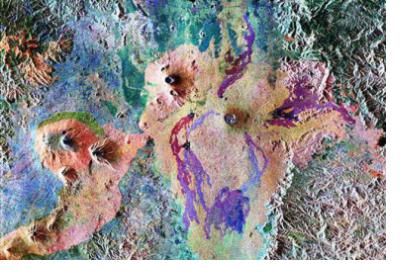The ‘Monitoring Volcanoes’ article made reference to a study of over 440 active volcanoes in 16 developing countries which revealed most volcanoes around the world are not monitored effectively or are not monitored at all: 384 volcanoes have rudimentary or no monitoring, out of which 65 volcanoes pose a high risk to large populations.
Earth observing satellites, such as ESA’s Envisat, can detect unrest of currently unmonitored volcanoes. Movement of magma underground may cause deformation of the surface above, thus InSAR can be used to monitor volcanoes. InSAR or Interferometric Synthetic Aperture Radar is a remote sensing technique where two or more radar images over the same area are combined to detect slight surface changes occurring between acquisitions. Tiny changes on the ground lead to rainbow coloured interference patterns in the combined image.
Thus Satellites are finding that volcanoes previously thought to be dormant are showing signs of unrest.

